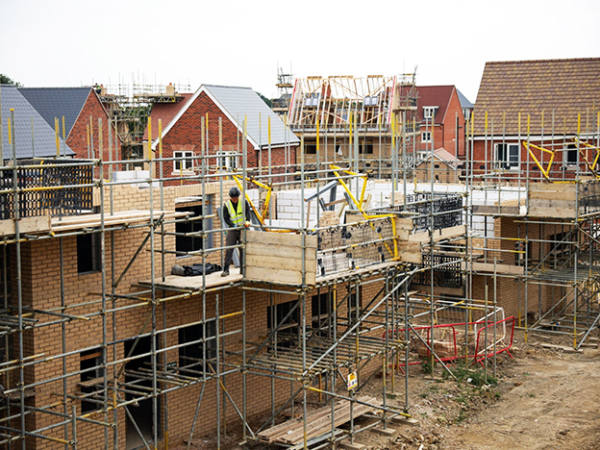Having examined both the wider housing market’s prospects and how housebuilding stocks in general behave through the cycle, in our final look at the sector we will look more closely at picking stocks within the UK listed universe. Before that, however, it is important to look at the significant changes in the mood music that have rapidly been brought about by the new Truss administration.
Last month we speculated about how long the new government could resist bringing in more support measures for the housing market. Not for long, it transpired. The Kwarteng mini-Budget lowered stamp duty land tax (SDLT), but the changes introduced are, in practice, pretty small beer. The maximum duty cut for most buyers is only £2,500, much less than the savings on offer in the 2020 stamp duty ‘holiday’: then up to £15,000 could be saved. First-time buyers in London can save more, but the housing market in the capital is a very different beast. Needless to say, the housebuilders are not satisfied and wanted more, as the new homes industry is today getting its lowest support from the government for more than a decade.
Those still bullish on the housing market perhaps assume that lowered SDLT would help repeat the massive price surge seen in 2020 and 2021. The saving on an average priced UK house was only £1,800, but that average price then rose by almost £58,000. A repeat of this is not likely because prices are considerably higher, mortgage rates are high and rising not low and falling, there is a personal financial crisis with cost of living pressures, and the pandemic ‘race for space’ that created a substantial surge in demand is unlikely to be repeated. Many found that the rural idyll did not live up to expectations.
Collapsing bonds, soaring mortgages
While we looked at the rise in mortgage rates just four weeks ago, the situation has materially worsened since. At the end of August, the benchmark 10-year UK gilt (government bond) yield was 2.6 per cent – this suggested that fixed mortgage rates (simplistically the benchmark rate + c25 basis points for the swap to fix the rate + c45 basis points for lender overheads + c45 basis points for the lender’s margins) might peak at around 3.75 per cent. However, as the new prime minister’s ‘bold’ economic policies have become clearer, the benchmark interest rate has shot up to 4.25 per cent. This suggests that five-year fixed-rate mortgages are most likely heading for an interest rate above 5 per cent on new loans. Just a year ago, the average 75 per cent loan-to-value (LTV) five-year fixed-rate loan cost just 1.28 per cent.
| Table 1: Cost of differing mortgage rates and maturities per £100,000 borrowed | |||||
|---|---|---|---|---|---|
Mortgage: length ↓ rate → | 1.50% | 2.50% | 3.50% | 4.50% | 5.50% |
25 years | £399.94 | £448.62 | £500.62 | £555.83 | £614.09 |
30 years | £345.12 | £395.12 | £449.04 | £506.69 | £567.79 |
35 years | £306.18 | £357.50 | £413.29 | £473.26 | £537.02 |
40 years | £277.17 | £329.78 | £387.39 | £449.56 | £515.77 |
45 years | £254.78 | £308.66 | £368.03 | £432.27 | £500.71 |
50 years | £237.01 | £292.14 | £353.20 | £419.39 | £489.85 |
| Source: Investors’ Chronicle | |||||
These higher rates must begin to limit the number of potential, capable borrowers while at the same time reducing what those buyers will be willing, and able, to pay for a house. So there is a heightened risk of a double hit: falling prices and falling activity. As we have previously outlined, a crash of 1989 or 2007 proportions does not feel likely, as there is no systematic risk to mortgage lenders and there are likely to be few forced sellers due to relatively low unemployment. However, this is enough to apply the brakes to the market and, when combined with steeply rising construction costs, housebuilders’ margins face a lot of pressure.
Pick a card, any card
Macro issues aside, we are looking at the what, when and how for investors considering this sector. Should investors be tempted back now many stocks are around half their 2022 highs – and, if so, what should be their focus?
Let’s look at the ‘what to buy’ question first. The answer could actually be pretty much any stock picked at random; when it comes to the housebuilders, there is an argument for abandoning stockpicking altogether. Despite there being differences between various housebuilders in terms of size, market focus and a few differences in their products, this is a very homogeneous sector. All experience the same pricing movements and suffer the same input cost issues with a very similar impact on both their profits and share prices. In the chart and table below we show that despite different size and quality of land holdings, perceived product quality, buyer profile, regional exposure, operating margins, core dividends and special distributions, across the cycle there is actually very little difference in the total returns on offer. Plus the direction of travel in share prices is almost always the same (see chart).
It used to be the case that if looking for one stock to buy and hold, Berkeley Group (BKG) was the choice. It is the most differentiated stock with an uncanny knack of calling turns in the cycle. But while Berkeley is the winner in the five-year total shareholder return (TSR) stakes, it is only by a nose, and over 10 years it is only mid-table. As no one stock really stands out, investors are likely to do equally well just picking almost at random. Stockpicking here is not the key: the key is timing.
Figure 1: Housebuilders tend to move as one
Source: FactSet
| Table 2: Annual total shareholder returns from the larger housebuilders | |||
|---|---|---|---|
Last 5 years | Annual TSR | Last 10 years | Annual TSR |
Berkeley | 1.54% | Redrow | 15.21% |
Redrow | -0.13% | Persimmon | 14.85% |
Vistry | -1.21% | Barratt | 14.49% |
Barratt | -1.63% | Berkeley | 14.20% |
Persimmon | -2.34% | Taylor Wimpey | 12.43% |
Bellway | -4.52% | Bellway | 12.12% |
Taylor Wimpey | -4.91% | Vistry | 9.19% |
| Source: FactSet | |||
If you have to pick…
That said, there are some housebuilders that have a slightly different angle or dimensions that could separate them out from the homogenous block somewhat. If nothing else, that does make them a little more interesting, perhaps even a little more defensive.
MJ Gleeson (GLE) – a small, regional housebuilder that sells ultra-low-price new homes primarily to lower-income households, often former council tenants. This is possible because it builds on sites the larger housebuilders do not want due to location or because of complications, making its land costs close to zero. By value engineering its construction to ensure it still delivers good quality homes, it makes similar margins to larger housebuilders while selling much cheaper homes. Its average price is £167,000 against Bellway’s (BWY) £283,000 in the same regions. In its latest figures, Gleeson made a 15 per cent margin while Bellway made 17.5 per cent.
Vistry (VSTY) – formerly Bovis Homes – is a company that can’t sit still. Buying Linden Homes from Galliford Try in 2019 and now Countryside Partnerships (CSP), this is a business with a different focus from the rest of the pack. While still primarily building homes for private sale, it has a substantial and fast-growing interest in social/affordable housing and major regeneration projects. This gives Vistry a defensive stripe that its peers do not have. Whether or not buying Countryside at this point in the cycle is right, Vestry did pounce when the share price was pretty much at an all-time low. Buying cheap equity with your own cheap, badly beaten-up equity reduces the risk of destroying value.
Taylor Wimpey (TW) is an interesting one from a dividend income perspective. All other housebuilders pay a dividend relative to their earnings per share (EPS), based on a ‘cover’ of, say, 2.5 times, but TW pays a dividend that is a percentage (7.5 per cent) of its net asset value (NAV) each year. This, and promises made at the time of the 2020 rights issue, mean it will be harder for TW to lower its dividend when profits begin to drop. Even if TW’s profits halved, its NAV would still rise and so would its dividend (so long as it sticks to its distribution policy). While we question others’ very high apparent yields and suspect dividend cuts in line with profits are likely, it is just possible that the 9 per cent that TW appears to offer might be real, whether or not the board is comfortable with that. There is enough cash on the balance sheet to pay two years’ worth of dividends even with zero profitability.
No rush whatever you choose
So, what about the timing of any new or renewed investment in the sector? Echoing a bored child on a long car journey: are we there yet? Whatever the outcome for the housing market or for the housebuilders, now still does not feel like the right time to buy. Whether analysts’ forecasts are trimmed or slashed, whether house prices fall or simply stop rising, or whether strong employment allows wages to counter higher mortgage costs, it is unlikely that the sector is going to turn in the immediate future.
This sector always needs triggers to change its direction. In the past couple of weeks we have had several positive catalysts: energy costs underwritten, the national insurance increase reversed, a basic-rate tax cut, stamp duty abolished for many buyers, and the corporation tax reversal pushing EPS up by 7-10 per cent – yet the sector is still falling. This suggests, in keeping with previous cycles, that we actually need a negative trigger or triggers to push the sector up, however perverse that may sound. That could be reversing house price indices, weakening mortgage approvals or falling monthly house sales, but is more likely to be forecasts for the housebuilders being cut.
We are now at the point where a major profit reversal is already priced into valuations, and when in theory we can begin to get the measure of how bad things might get for mortgage rates, house prices and levels of market activity. However, while these things become more visible, feel more tangible and justify the sector’s de-rating through 2022, as the final piece of the jigsaw we do still need analysts to begin making forecasts based on the new reality. Until we see that or – much less likely – the key macroeconomic pressures begin to reverse, the sector is more likely to drift lower and it is best to stand back in the meantime. However, a keen watch is needed, because when the turnaround comes, stocks are likely to move rapidly.











